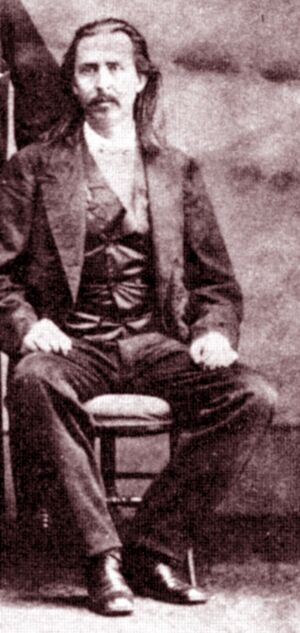William Penn Adair facts for kids
William Penn Adair (1830–1880) was an important leader of the Cherokee Nation. He was a lawyer and served in many government roles for his people. He was also a judge in their court.
During the American Civil War, he joined the Confederate States Army. He became a colonel. The Confederacy had promised to help create an independent Native American state if they won the war.
Adair also worked as a representative for the Cherokee Nation in Washington, DC. He did this during the 1860s and 1870s. When he was a child, his family was forced to move from their home in Georgia. This difficult journey was part of the Trail of Tears. They moved to Indian Territory, which is now Oklahoma.
Contents
Early Life and Education
William Penn Adair was born on April 15, 1830. His birthplace was in the old Cherokee Nation, near New Echota, Georgia. His parents were George Washington Adair and Martha Adair.
In 1838, his family was forced to move to Indian Territory. This event is known as the Trail of Tears. Many Cherokee people died during this sad journey.
Adair went to Cherokee schools in Indian Territory. He also studied law to become a lawyer. He joined the Freemasons, a social organization. People described him as a tall, friendly, and very smart person.
Adair married Sarah Ann McNair. After she passed away, he married Susannah "Sue" McIntosh Drew. He lived near the Grand River in what is now Adair, Oklahoma. The town was named after him.
Serving in the Civil War
During the American Civil War, William Penn Adair fought for the Confederate States Army. He first served in the First Regiment of Cherokee Mounted Volunteers. This group was led by General Stand Watie.
The Confederacy had promised Native American nations that they would support a Native American-controlled state if they won the war. Adair became a colonel and helped organize the Second Cherokee Mounted Volunteers.
A Leader for the Cherokee Nation
William Penn Adair held many important jobs for the Cherokee Nation. He was a senator, a judge on the Cherokee Supreme Court, and a delegate to Washington, DC. He also served as Assistant Principal Chief.
He was a senator for the Flint District from 1855 to 1860. Later, he was a senator for the Saline District from 1869 to 1874. In 1879, he was chosen as Assistant Chief. Throughout the 1860s and 1870s, Adair represented the Cherokee Nation in Washington.
Fighting for Land Rights
Adair strongly supported the rights of the Texas Cherokees. He led the Texas Cherokees and Affiliated Bands from 1871 until his death. In 1873, he co-wrote a book called History of the Claim of the Texas Cherokees. This book explained their claim for land.
The Texas Cherokees wanted money or land back from the state of Texas. Their lands were taken from them in 1839. At that time, the Republic of Texas was independent. Its president, Mirabeau Lamar, forced most Texas Cherokees to move to Indian Territory. He then took their lands in East Texas.
The Texas Cherokees wanted about 1,500,000 acres (6,100 km2) of land back. In the 1850s, Texas offered them land in the Texas Panhandle. But Adair did not accept this offer. The Texas Cherokees continued to try to get their land back for many years, even after Adair's death.
His Final Years and Lasting Impact
William Penn Adair passed away on October 23, 1880, while in Washington, DC. He was first buried in Arlington National Cemetery. But soon after, his body was moved to the Tahlequah City Cemetery in Tahlequah, Oklahoma. The Cherokee Nation paid for this move.
Many Cherokee boys were named after him in the late 1800s. One famous person named after him was the humorist Will Rogers, whose full name was William Penn Adair Rogers. The town of Adair, Oklahoma was named for William Penn Adair and his brother, Dr. Walter Thompson Adair.
In 1955, he was honored by being added to the Hall of Great Westerners. This is part of the National Cowboy & Western Heritage Museum.


